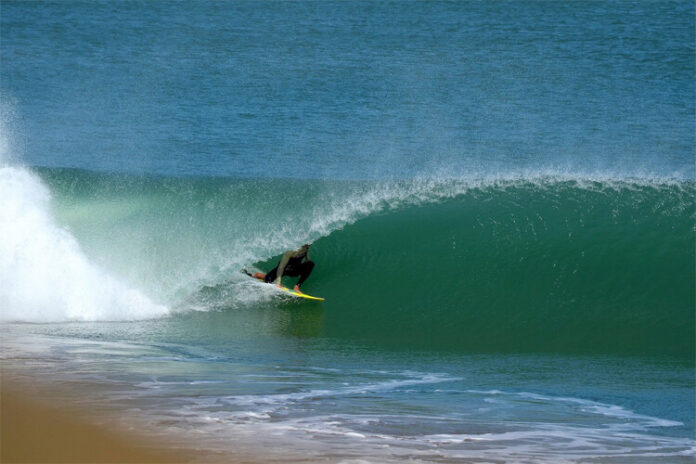Surfing is a free recreational outdoor activity with approximately 35 million participants worldwide.
In search of perfect waves, surfers travel all around the world and engage with thousands of coastal communities all-year-round.
The concept of surf economics – also known as surfonomics – has been used by environmental, surf-related non-governmental organizations (NGO) like Save The Waves Coalition and Surfrider Foundation to evaluate economic benefits derived from surfing.
The analysis always takes into consideration the increasing number of harmful coastal developments and pollution events that threaten surf spots.
Surf economics quantifies the economic benefits that surf tourism brings to local communities while simultaneously addresses and promotes the need for a coastal conservation mindset.
Surfonomics applies natural resource economics to better understand the economic value of waves and surfing to coastal communities and the consumer surplus that surf breaks provide to millions of surfers.
The cost-benefit studies applied to surf tourism are not new, but the first systematic analysis of waves’ value got its first public impact in 2001.
Chad Nelsen, the CEO of Surfrider Foundation (2016-), teamed up with his colleague Ken Lindeman and Duke University economist Linwood Pendleton to develop a quick economic assessment for a condominium project that would destroy the waves in Rincon, Puerto Rico.
The team was able to show how much revenue was coming into town from welcoming surfers from all over the world.
As a result, the construction was stopped, and the local authorities established a marine reserve.

The Surfonomics Method
Several research studies followed.
Save The Waves Coalition is an international nonprofit that works with national and local organizations to protect surf ecosystems that might be at risk.
In 2008, Save The Waves kicked off a series of surveys and data collection programs that resulted in several commissioned surf economic studies.
Since then, surfonomics contributed to creating and developing the World Surfing Reserves (WSR) program.
WSR is an advocacy mechanism developed to influence government policies and help decision-makers make better choices to protect key environmental, cultural, economic, and community characteristics of world-class surf spots and their surrounding areas.
Several famed surf breaks already know the economic impact of surf tourism on the local economy, including Mundaka (Spain), Mavericks (California), Uluwatu (Bali), Pichilemu (Chile), Huanchaco (Peru), San Miguel (Mexico), Guarda do Embaú (Brazil), and Lobitos (Peru).
These studies applied the direct expenditure method of economic evaluation to estimate the market value of surfing for the local economy.
The results of these eight studies sum up to $250 million per year.
In Australia, the Gold Coast City Council invited Neil Lazarow to carry out a similar surf economics study to support its shoreline management plan.
“Surfing also produces significant non-market value, which comes from the welfare and benefits that surfing provides to millions of surfers, that cannot be measured by the direct expenditure methods,” Save The Waves underline.
“The most common type of non-market value studied in surfing is consumer surplus, estimated by the travel cost method (TCM).”
“It represents the aggregate willingness-to-pay above and beyond what people are currently paying to reach the surf location.”
Nelsen also applied TCM to estimate the non-market value of surfing at Trestles, California, and found an average consumer surplus of surfing to be $138 per person per visit.
Figures don’t lie.
For decades, hundreds of oil derricks and oil towers invaded the dunes and shoreline of Southern California, extending into the Pacific, and creating post-apocalyptic postcard scenes and landscapes.

Surf Tourism Matters
Fortunately, that era is over. But why were oil derricks removed from the California landscape? The wells were running and dry, and the tourism industry was going up.
So, to make decisions based on rational arguments and valid options, local communities must know what’s at stake beyond the first layer of fast money and immediate opportunities.
The non-market value of surfing can also be estimated by the hedonic pricing method.
“As surfers choose to live close to surf spots, they have no travel costs,” the NGO adds.
“However, they pay much higher prices for a house. Therefore, part of the non-market value of surfing would be capitalized into real estate value.”
In 2015, Jason Scorse, Frank Reynolds, and Amanda Sackett studied the “Impact of Surf Breaks on Home Prices in Santa Cruz, CA.”
They applied the hedonic pricing method to analyze the impact of surf spots on home prices in the iconic Northern California surf town.
In the end, they found that beach houses close to surf breaks are worth hundreds of thousands of dollars more than similar beach houses far from well-known surfing waves.
Surfonomics’ research method and model uses direct expenditure data from visiting surfer tourists to estimate the economic value that a world-class wave brings to the local community.
In most cases, the results show that waves should be treated as sustainable natural assets through their proper economic valuation.
In the end, local communities and tourism business operators end up with a better understanding of tourist’s expectations and their opportunities to improve their experience in their towns and villages.
The surf economics model created in California is now applied to several countries and adapted and fine-tuned to their unique contexts.





